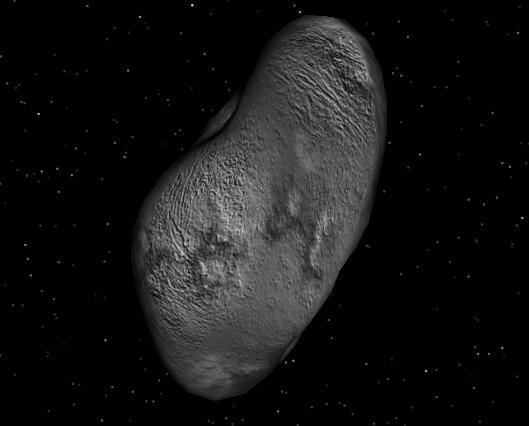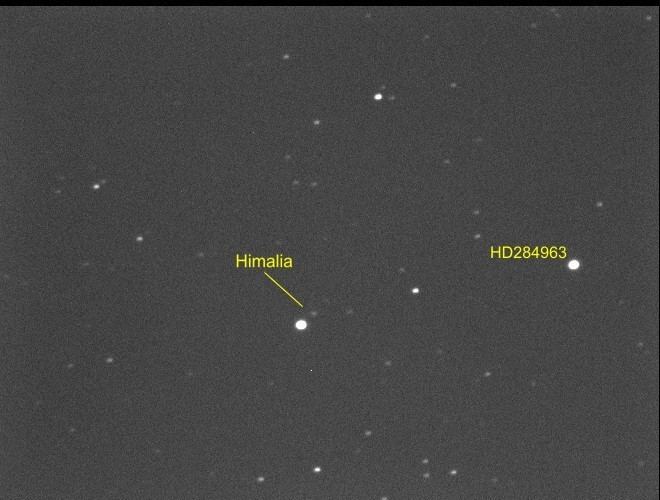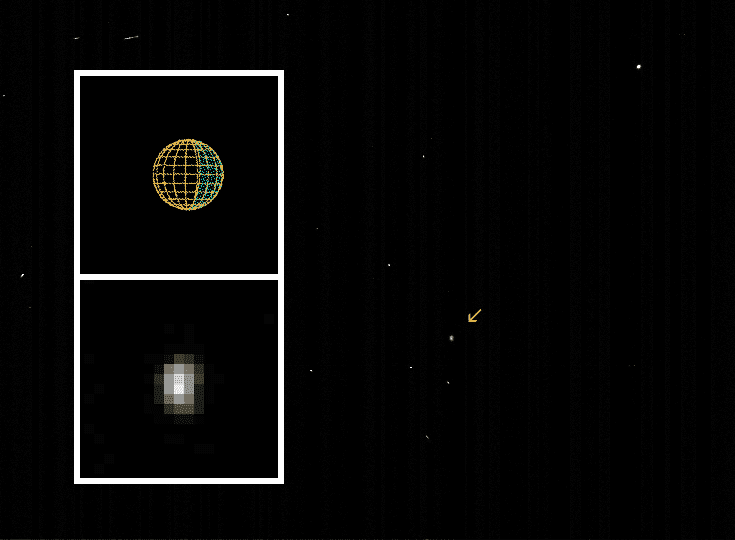Discovered by C. D. Perrine Adjectives Himalian Apoapsis 13,082,000 km Discovered 3 December 1904 Absolute magnitude 14.6 | Discovery date December 3, 1904 Periapsis 9,782,900 km Mean orbit radius 11,460,000 km | |
 | ||
Similar Jupiter moons, Other celestial objects | ||
Himalia (/haɪˈmeɪliə/ hy-MAY-lee-ə or /hɪˈmɑːliə/ hi-MAH-lee-ə; Greek: ‘Ιμαλíα) is the largest irregular satellite of Jupiter, the sixth largest overall in size, and only the four Galilean moons of Jupiter have greater Mass. It was discovered by Charles Dillon Perrine at the Lick Observatory on 3 December 1904 and is named after the nymph Himalia, who bore three sons of Zeus (the Greek equivalent of Jupiter). It is one of the largest planetary moons in the Solar System not imaged in detail, and the largest not including the moons of Neptune and several trans-Neptunian objects, particularly that of the second-largest-but-most-massive dwarf planet, Eris.
Contents
- Discovery
- Name
- Orbit
- Physical characteristics
- Mass
- Exploration
- Possible relationship with Jupiters rings
- References

Discovery

Himalia was discovered by Charles Dillon Perrine at the Lick Observatory on 3 December 1904. Himalia is Jupiter's most easily observed small satellite; though Amalthea is brighter, its proximity to the planet's brilliant disk makes it a far more difficult object to view.
Name

Himalia is named after the nymph Himalia, who bore three sons of Zeus (the Greek equivalent of Jupiter). The moon did not receive its present name until 1975; before then, it was simply known as Jupiter VI or Jupiter Satellite VI, although calls for a full name appeared shortly after its and Elara's discovery; A.C.D. Crommelin wrote in 1905:
Unfortunately the numeration of Jupiter's satellites is now in precisely the same confusion as that of Saturn's system was before the numbers were abandoned and names substituted. A similar course would seem to be advisable here; the designation V for the inner satellite [Amalthea] was tolerated for a time, as it was considered to be in a class by itself; but it has now got companions, so that this subterfuge disappears. The substitution of names for numerals is certainly more poetic.
The moon was sometimes called Hestia, after the Greek goddess, from 1955 to 1975.
Orbit
At a distance of about 11.5 million km from Jupiter, Himalia takes about 251 Earth days to complete one orbit. It is the largest member of the group that bears its name, the moons orbiting between 11.4 and 13 million kilometers from Jupiter at an Inclination of about 27.5°. The orbital elements are as of January 2000. They are continuously changing due to solar and planetary perturbations.
Physical characteristics
Himalia's rotational period is 7004252000000000000♠7 h 7001460000000000000♠46 m 7001550000000000000♠55±2 s. Himalia appears neutral in color (grey), like the other members of its group, with colour indices B−V=0.62, V−R=0.4, similar to a C-type asteroid. Measurements by Cassini confirm a featureless spectrum, with a slight absorption at 6994300000000000000♠3 µm, which could indicate the presence of water.
Mass
In 2005, Emelyanov estimated Himalia to have a mass of 7018419000000000000♠4.19×1018 kg (GM=0.28), based on a perturbation of Elara on July 15, 1949. JPL's Solar System dynamics web site assumes that Himalia has a mass of 7018670000000000000♠6.7×1018 kg (GM=0.45) with a radius of 7004850000000000000♠85 km.
Himalia's density will depend on whether it has an average radius of about 7004670000000000000♠67 km (geometric mean from Cassini) or a radius closer to 7004850000000000000♠85 km.
Exploration
In November 2000, the Cassini spacecraft, en route to Saturn, made a number of images of Himalia, including photos from a distance of 4.4 million km. Himalia covers only a few pixels, but seems to be an elongated object with axes 7002150000000000000♠150±20 and 7005120000000000000♠120±20 km, close to the Earth-based estimations.
In February and March 2007, the New Horizons spacecraft en route to Pluto made a series of images of Himalia, culminating in photos from a distance of eight million km. Again, Himalia appears only a few pixels across.
Possible relationship with Jupiter's rings
The small moon Dia, 4 kilometres in diameter, had gone missing since its discovery in 2000. One theory was that it had crashed into the much larger moon Himalia, 170 kilometres in diameter, creating a faint ring. This possible ring appears as a faint streak near Himalia in images from NASA's New Horizons mission to Pluto. This suggests that Jupiter sometimes gains and loses small moons through collisions. However, the recovery of Dia in 2010 and 2011 disproves the link between Dia and the Himalia ring, although it is still possible that a different moon may have been involved.
